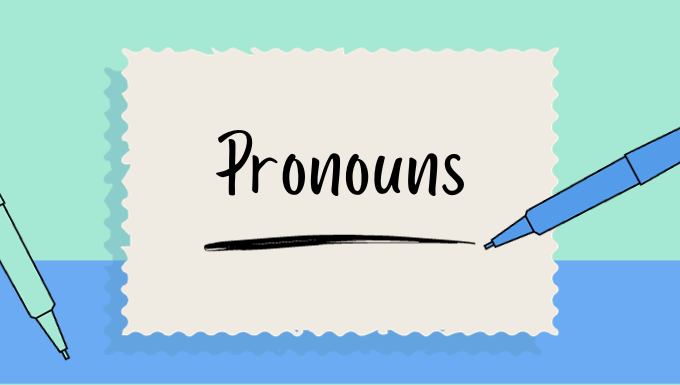
Introduction
Welcome to our straightforward guide on pronouns! Pronouns are a fundamental part of English grammar, yet they can be confusing. This post aims to demystify pronouns, making them easy for everyone to understand. Whether you’re a language learner, a grammar enthusiast, or just someone curious about English, this guide is for you.
What are Pronouns?
Pronouns are words used in place of nouns. They help us avoid repeating the same nouns over and over again, making our sentences cleaner and easier to read and understand. For example, instead of saying “Maria went to Maria’s car,” we say “Maria went to her car.” Here, ‘her’ is a pronoun replacing ‘Maria’s.’
Types of Pronouns
- Personal Pronouns
- These refer to specific people or things. They change based on number (singular or plural), person (first, second, or third person), and gender. Examples include ‘I’, ‘you’, ‘he’, ‘she’, ‘it’, ‘we’, and ‘they’.
- Possessive Pronouns
- These show ownership or possession. Examples are ‘my’, ‘your’, ‘his’, ‘her’, ‘its’, ‘our’, and ‘their’. When used before nouns, they’re possessive adjectives (e.g., my book), and when standing alone, they’re possessive pronouns (e.g., mine).
- Reflexive Pronouns
- These are used when the subject and the object of a sentence are the same. For example, “I taught myself.” ‘Myself’ is a reflexive pronoun.
- Relative Pronouns
- Used to connect clauses or phrases, for example, ‘who’, ‘whom’, ‘whose’, ‘which’, and ‘that’.
- Demonstrative Pronouns
- These are used to point to specific things. Examples are ‘this’, ‘that’, ‘these’, and ‘those’.
- Indefinite Pronouns
- They refer to nonspecific things or people, like ‘someone’, ‘anything’, ‘each’, and ‘many’.
Examples of Pronouns
Here are examples of different types of pronouns along with explanations for each:
- Personal Pronoun:
- Example: “She is reading a book.”
- Explanation: “She” is a personal pronoun that stands in for the name of the woman or girl who is performing the action of reading.
- Possessive Pronoun:
- Example: “That book is mine.”
- Explanation: “Mine” is a possessive pronoun indicating ownership. It means the book belongs to the speaker.
- Reflexive Pronoun:
- Example: “I prepared myself for the exam.”
- Explanation: “Myself” is a reflexive pronoun. It’s used when the subject (“I”) is the same as the object (the person being prepared).
- Relative Pronoun:
- Example: “The athlete who won the race is my friend.”
- Explanation: “Who” is a relative pronoun that introduces a relative clause (“who won the race”), providing more information about the noun (“the athlete”).
- Demonstrative Pronoun:
- Example: “This is my favorite song.”
- Explanation: “This” is a demonstrative pronoun used to indicate a specific object (in this case, “my favorite song”) close to the speaker.
- Indefinite Pronoun:
- Example: “Someone left their bag here.”
- Explanation: “Someone” is an indefinite pronoun, referring to an unspecified person.
- Interrogative Pronoun:
- Example: “Whom did you see at the party?”
- Explanation: “Whom” is an interrogative pronoun used to ask a question about the object of the action (the person seen at the party).
- Reciprocal Pronoun:
- Example: “They help each other.”
- Explanation: “Each other” is a reciprocal pronoun indicating a mutual or two-sided action or relationship between the subjects (“They”).
These examples illustrate how different types of pronouns function in sentences, replacing nouns and providing clarity, efficiency, and variety in language use.
List of Pronouns
Here’s a list of pronouns categorized in a tabular format:
| Type of Pronoun | Examples |
|---|---|
| Personal | I, you, he, she, it, we, they |
| Possessive | mine, yours, his, hers, ours, theirs |
| Reflexive | myself, yourself, himself, herself, itself, ourselves, yourselves, themselves |
| Relative | who, whom, whose, which, that |
| Demonstrative | this, that, these, those |
| Indefinite | someone, anyone, everyone, no one, nothing, everything, few, many |
| Interrogative | who, whom, whose, which, what |
| Reciprocal | each other, one another |
This table provides a clear and organized overview of various pronouns and their examples, making it easier to understand and identify them in language use.
Why are Pronouns Important?
Pronouns are crucial in English because they help us avoid repetition and make our sentences more fluid. They also play a key role in showing possession, pointing out specific things, and connecting ideas. Without pronouns, communication would be repetitive and less efficient.
Conclusion
Pronouns may seem small, but they’re mighty in the English language. By replacing nouns, indicating possession, and connecting ideas, pronouns keep our sentences neat and our communication clear. We hope this simple guide helps you understand and use pronouns effectively in your daily communication.
Pronouns FAQs
Here are some frequently asked questions (FAQs) about pronouns, designed to clarify their use and types in English grammar:
- What are pronouns?
- Pronouns are words that take the place of nouns in a sentence, helping to avoid repetition and make sentences more concise. They can refer to people, animals, objects, or concepts.
- Why are pronouns important?
- Pronouns are crucial for making language more efficient and less repetitive. They help in maintaining sentence flow and clarity, especially in complex or lengthy discussions.
- What are the different types of pronouns?
- The main types include personal pronouns (I, you, he, she, it, we, they), possessive pronouns (mine, yours, his, hers, ours, theirs), reflexive pronouns (myself, yourself, himself), demonstrative pronouns (this, that, these, those), relative pronouns (who, whom, whose, which, that), and indefinite pronouns (anyone, everybody, something, none).
- Can pronouns change form?
- Yes, many pronouns change form based on their function in a sentence, like subjective (I, you, he), objective (me, you, him), and possessive (my/mine, your/yours, his) forms.